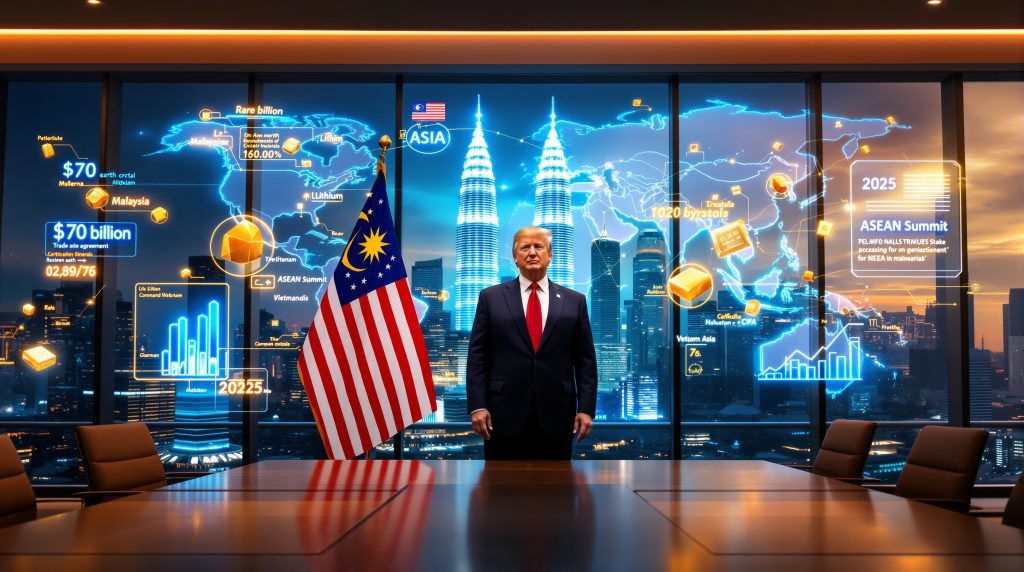Understanding the 2025 Kuala Lumpur Trade Summit Framework
The October 2025 ASEAN Summit in Kuala Lumpur established a transformative moment for U.S.-Southeast Asia economic relations, creating bilateral trade frameworks with four strategic partners. Trump's Southeast Asia trade agreements introduce preferential trading mechanisms while directly addressing supply chain vulnerabilities that have intensified throughout the previous decade.
The agreements represent the most significant shift in critical minerals security architecture since the 2019 U.S.-Japan magnet initiative, positioning America at the centre of a new economic framework that challenges existing supply chain dependencies in the Indo-Pacific region.
Core Components of the New Trade Architecture
The bilateral frameworks establish several foundational elements that distinguish them from previous multilateral approaches:
- Reciprocal market access provisions creating preferential treatment for American industrial goods, aerospace components, and semiconductor products
- Critical minerals security partnerships featuring explicit export guarantee mechanisms
- Export control alignment systems coordinating sensitive materials and technology management
- Investment protection frameworks safeguarding bilateral economic commitments through dispute resolution procedures
Strategic Timing and Regional Context
These agreements emerge during a period of intensified global competition for strategic materials, particularly as traditional supply chains face mounting geopolitical pressures. Furthermore, Southeast Asia's mineral-rich geological formations position these nations as essential partners in diversifying resource dependencies away from concentrated supplier relationships.
The timing coincides with increased awareness of supply chain vulnerabilities exposed during recent global disruptions, creating urgency around establishing alternative sourcing arrangements for materials critical to advanced manufacturing and defense materials strategy applications.
How Does the Malaysia Agreement Reshape Critical Minerals Trade?
Malaysia's comprehensive trade accord introduces groundbreaking provisions for critical minerals cooperation, establishing the first bilateral framework specifically prohibiting export restrictions on rare earth elements destined for U.S. markets. This represents an unprecedented commitment in international trade relations regarding strategic materials.
Key Economic Provisions and Investment Commitments
| Sector | U.S. Benefits | Malaysian Commitments |
|---|---|---|
| Critical Minerals | Guaranteed export access | $70 billion investment pledge |
| Manufacturing | Preferential market entry | Refining capacity expansion |
| Technology | Joint development programs | Environmental compliance standards |
| Agriculture | Enhanced market access | Labour protection alignment |
The $70 billion investment commitment represents one of the largest bilateral economic pledges in Southeast Asian trade history, targeting downstream processing capabilities and technology transfer partnerships that could fundamentally alter regional supply chain dynamics.
Rare Earth Elements Security Framework
The agreement establishes joint exploration initiatives and processing partnerships designed to address long-standing concerns about supply chain concentration in rare earth elements. However, Malaysia commits to maintaining open export channels while developing domestic refining capabilities through American technical assistance and investment support.
This framework specifically targets light rare earth elements (LREEs) and heavy rare earth elements (HREEs), with provisions for technology transfer in separation and purification processes. Consequently, the arrangement could significantly impact global pricing dynamics for neodymium, dysprosium, and terbium used in permanent magnet applications.
What Makes Cambodia's Zero-Tariff Approach Unique?
Cambodia's agreement transcends traditional trade arrangements by implementing complete tariff elimination on all U.S. goods while simultaneously opening its emerging mineral sector to American exploration and infrastructure investment. This comprehensive approach creates unprecedented market access opportunities.
Defence and Economic Integration
The Cambodian framework integrates multiple strategic elements:
- Complete arms embargo removal restoring defence trade relationships
- Joint military exercise restoration strengthening security cooperation
- Mining sector liberalisation providing equal treatment for American firms
- Infrastructure development partnerships supporting mineral extraction and processing capabilities
Mineral Exploration Opportunities
Cambodia's untapped geological potential offers significant opportunities for critical minerals discovery, particularly in rare earth deposits and battery-critical materials. Moreover, the equal treatment provisions ensure American exploration companies receive fair access to permits and development rights, creating competitive advantages in an underexplored market.
Early geological surveys suggest potential for both ionic clay deposits similar to those found in southern China and hard rock formations containing mixed rare earth concentrations. However, infrastructure limitations and regulatory frameworks remain development challenges requiring substantial investment.
How Will Thailand's Price-Floor Mechanisms Impact Global Markets?
Thailand's framework agreement introduces innovative price-floor cooperation mechanisms designed to prevent market manipulation through artificial pricing strategies, particularly relevant given concerns about dumping practices in critical minerals markets that have historically disrupted fair competition.
Technology Transfer and Joint Ventures
Thailand's commitment to technology transfer represents a fundamental shift from traditional resource extraction models toward value-added processing partnerships that enhance both nations' industrial capabilities while reducing dependency on external processing facilities.
The technology transfer provisions focus specifically on mineral separation techniques, magnetic material processing, and recycling technologies that could establish Thailand as a regional processing hub for rare earth materials and other critical minerals.
Export Control Alignment Strategy
The bilateral alignment on export controls creates a coordinated approach to managing sensitive materials and technologies, strengthening both nations' national security frameworks while facilitating legitimate trade relationships. Furthermore, this coordination extends to dual-use technologies and materials with potential military applications.
Thailand's commitment to align export control policies with U.S. standards represents a significant departure from traditional non-aligned positions, potentially influencing broader regional approaches to technology transfer and strategic materials management.
What Does Vietnam's $8 Billion Boeing Deal Signal for Regional Trade?
Vietnam's "Fair and Balanced Trade" framework extends beyond traditional commerce to include digital trade provisions, data transfer agreements, and state enterprise behaviour modifications. The landmark $8 billion Vietnam Airlines-Boeing agreement demonstrates the scale of economic cooperation possible under these new frameworks.
Digital Economy Integration
The Vietnam agreement establishes comprehensive digital trade provisions:
- Cross-border data flow facilitation enabling seamless information exchange
- E-commerce platform cooperation supporting digital marketplace development
- Intellectual property protection enhancement strengthening enforcement mechanisms
- Digital services market access opening telecommunications and technology sectors
Aviation and Industrial Partnerships
The Vietnam Airlines-Boeing agreement represents more than aircraft procurement, signalling broader aerospace manufacturing and maintenance partnerships throughout the region. This $8 billion commitment includes technology transfer provisions that could establish Vietnam as a regional aerospace manufacturing hub.
The agreement encompasses not only aircraft delivery but also maintenance, training, and component manufacturing partnerships that could create significant employment and technology transfer opportunities while strengthening bilateral economic ties. In addition, this collaboration mirrors the lithium industry innovations seen in other strategic sectors.
Why Are These Agreements Significant for Critical Minerals Security?
Each agreement contains explicit provisions addressing critical minerals supply chain resilience, creating a coordinated approach to reducing dependency on single-source suppliers whilst establishing alternative processing and refinement capabilities across multiple nations.
Supply Chain Diversification Strategy
Before 2025 Agreements:
- Heavy reliance on concentrated supply sources controlling over 80% of global rare earth processing
- Limited processing alternatives outside traditional suppliers
- Vulnerable export restriction exposure affecting strategic industries
After Implementation:
- Multiple supplier relationships across four Southeast Asian partners
- Distributed processing capabilities reducing concentration risks
- Export security guarantees protecting against supply disruptions
Processing Capacity Development
The agreements emphasise downstream processing development rather than raw material extraction alone, creating value-added opportunities while strengthening supply chain resilience. Furthermore, this approach addresses the critical gap between mining and finished product manufacturing that has historically concentrated market power.
Processing capacity development targets include separation facilities for individual rare earth elements, magnet manufacturing capabilities, and recycling technologies for end-of-life products containing critical materials. This aligns with broader mining industry evolution trends towards more sophisticated processing approaches.
What Challenges Could Undermine These Trade Agreements?
Despite their comprehensive scope, several execution risks could limit the agreements' effectiveness in achieving their strategic objectives, particularly given the complex technical and financial requirements involved in critical minerals processing.
Implementation Timeline Concerns
Several factors could extend implementation timelines beyond initial projections:
- Refining capacity development requires multi-year investment cycles with significant technical expertise requirements
- Mineral exploration and development involve lengthy approval processes and geological uncertainties
- Infrastructure projects face regulatory hurdles and environmental compliance requirements
- Technology transfer programmes need substantial workforce training and equipment procurement
Competitive Response Scenarios
Potential market disruptions could emerge through various competitive mechanisms:
- Aggressive pricing strategies from competing suppliers attempting to maintain market share
- Processing capacity limitations during transition periods creating supply bottlenecks
- Regulatory challenges in partner countries affecting project implementation timelines
- Technical difficulties in establishing processing facilities meeting quality and environmental standards
How Might China Respond to America's Southeast Asia Strategy?
Trump's Southeast Asia trade agreements create direct competition with existing regional economic relationships, potentially triggering strategic responses across multiple sectors as traditional suppliers seek to maintain market position and influence.
Economic Countermeasures Analysis
| Potential Response | Impact Level | Timeframe |
|---|---|---|
| Pricing Competition | High | Immediate |
| Processing Capacity Expansion | Medium | 2-3 years |
| Alternative Partnership Development | Medium | 1-2 years |
| Technology Transfer Acceleration | Low | 3-5 years |
Market Dynamics and Pricing Pressure
Competitive responses could include market flooding strategies or preferential pricing for non-aligned partners, requiring careful monitoring of global pricing trends and supply availability. Historical precedents suggest such responses could temporarily depress prices whilst increasing market volatility.
Price manipulation through below-cost selling has previously been employed to discourage alternative supplier development, though such strategies typically prove unsustainable over extended periods. Consequently, these tactics may accelerate rather than delay supply chain diversification efforts.
What Investment Opportunities Emerge from These Agreements?
The trade frameworks create multiple investment channels across sectors, from direct mineral extraction to downstream processing and manufacturing, with significant financing support anticipated through U.S. government programmes.
Infrastructure Development Priorities
Investment opportunities span multiple infrastructure categories:
- Port and transportation facility upgrades supporting increased trade volumes and specialised materials handling
- Processing plant construction establishing separation and refinement capabilities
- Technology transfer facilities enabling skills development and equipment manufacturing
- Environmental compliance systems meeting international standards for sustainable operations
Financing Mechanisms and Support
Expected support through Export-Import Bank (EXIM) and Development Finance Corporation (DFC) programmes could accelerate project implementation whilst reducing investment risks for participating companies. These mechanisms typically provide loan guarantees, direct financing, and political risk insurance for qualifying projects.
Historical EXIM and DFC support for similar projects suggests financing packages could cover up to 85% of project costs for qualifying infrastructure and manufacturing investments, significantly reducing private sector capital requirements. This mirrors the success seen in other countries' raw materials facility developments.
How Do These Deals Compare to Previous Trade Initiatives?
The 2025 agreements represent a fundamental departure from previous multilateral approaches, focusing on bilateral relationships with specific strategic objectives rather than comprehensive regional frameworks like the Trans-Pacific Partnership.
Evolution from TPP Withdrawal
Unlike the Trans-Pacific Partnership's comprehensive multilateral framework, these bilateral agreements allow for:
- Customised provisions per country addressing specific economic and security priorities
- Faster negotiation and implementation avoiding complex multilateral consensus requirements
- Specific strategic objective targeting focusing on critical minerals and security cooperation
- Enhanced flexibility in terms modification enabling rapid responses to changing circumstances
Critical Minerals Focus Integration
Previous trade agreements rarely integrated national security considerations with commercial arrangements to this degree, representing a new model for strategic economic partnerships that explicitly links trade policy with supply chain security objectives.
This integration reflects growing recognition that certain materials and technologies require special consideration beyond traditional commercial trade frameworks. However, this acknowledges their strategic importance for national defence and economic competitiveness.
What Timeline Should Stakeholders Expect for Implementation?
Implementation phases will vary significantly by country and sector, with some provisions taking effect immediately whilst others require extended development periods spanning multiple years for full operational capability.
Short-Term Milestones (6-12 months)
- Tariff reduction implementation providing immediate cost advantages for qualifying products
- Export restriction removal eliminating existing barriers to material flows
- Initial investment commitments beginning infrastructure and capacity development projects
- Regulatory framework adjustments aligning policies with agreement provisions
Medium-Term Developments (1-3 years)
- Processing facility construction begins with site preparation and equipment procurement
- Joint exploration projects launch identifying and developing new mineral resources
- Technology transfer programmes initiate providing training and equipment for local operations
- Supply chain integration advances connecting new facilities with existing distribution networks
Long-Term Strategic Goals (3-5 years)
- Full processing capacity operational achieving target production volumes for critical materials
- Significant supply chain diversification achieved reducing dependency on traditional suppliers
- Regional economic integration deepened through expanded trade and investment relationships
- Strategic objectives fully realised providing sustainable alternatives for critical materials supply
Investment Considerations and Market Psychology
The agreements create complex investment dynamics requiring careful analysis of both opportunities and risks. Furthermore, market psychology around critical minerals security has shifted dramatically, with strategic considerations increasingly outweighing purely economic factors in investment decisions.
Key investment themes include:
- Processing capacity premiums as downstream capabilities command higher valuations than raw material extraction
- Geographic diversification benefits reducing political and operational risks through multiple sourcing arrangements
- Technology transfer advantages providing competitive benefits through advanced processing techniques
- Long-term contract security offering stable revenue streams through government-backed agreements
According to recent trade analysis from Reuters, these developments represent the most significant shift in U.S.-Asia trade policy since the pivot away from multilateral frameworks.
Regional Economic Impact Assessment
The comprehensive nature of Trump's Southeast Asia trade agreements extends beyond traditional trade metrics to encompass strategic security considerations. Economic modelling suggests these frameworks could redirect approximately $200 billion in annual trade flows over the next decade.
Moreover, the agreements establish precedents for linking national security priorities with commercial trade arrangements, creating templates for future strategic partnerships. This approach reflects evolving understanding of economic interdependence and its security implications.
Geological Factors and Resource Quality Considerations
The success of these agreements depends significantly on the geological characteristics and resource quality available across partner nations. Southeast Asia's complex geological history creates diverse mineralisation patterns with varying economic potential.
Malaysia's geological advantages include:
- Established rare earth processing infrastructure through existing facilities
- Proven reserves of mixed light and heavy rare earth elements
- Advanced separation technology capabilities developed over multiple decades
- Strategic location for regional processing hub development
Thailand's mineral potential encompasses:
- Unexplored areas with geological similarity to proven rare earth provinces
- Existing mining expertise in other mineral sectors providing operational foundation
- Infrastructure connectivity supporting efficient materials transport
- Regulatory frameworks adaptable to critical minerals development
Cambodia's emerging opportunities feature:
- Preliminary geological surveys indicating rare earth potential in multiple provinces
- Limited previous exploration creating discovery opportunities
- Government commitment to resource development through favourable policies
- Strategic location connecting regional supply chains
Regulatory Framework Evolution
The agreements require significant regulatory alignment across multiple jurisdictions, creating standardised approaches to environmental protection, labour standards, and export controls. This regulatory harmonisation represents a substantial undertaking requiring coordination between diverse legal systems.
Environmental compliance standards address:
- Waste management protocols for rare earth processing operations
- Water treatment requirements protecting local water resources
- Air quality standards limiting emissions from processing facilities
- Land restoration requirements for mining operations
Export control coordination involves:
- Dual-use technology transfer restrictions ensuring security compliance
- Material classification systems standardising strategic materials definitions
- End-user verification procedures preventing unauthorised diversions
- Information sharing protocols supporting enforcement cooperation
Furthermore, as reported by The Wall Street Journal, the regulatory alignment process represents one of the most comprehensive attempts at trade harmonisation in the region's history.
Technical Processing Considerations
Successful implementation requires mastering complex technical processes for rare earth separation and purification. These processes demand substantial expertise, specialised equipment, and consistent quality control measures to produce materials meeting international specifications.
Critical technical factors include:
- Separation efficiency determining the purity levels achievable for individual elements
- Processing costs affecting economic competitiveness with existing suppliers
- Environmental management ensuring sustainable operations meeting international standards
- Quality control systems maintaining consistent product specifications for demanding applications
The technical complexity of rare earth processing creates significant barriers to entry, requiring substantial investment in both equipment and expertise development. Consequently, historical experience suggests that establishing competitive processing capabilities typically requires 3-5 years of intensive development efforts.
Note: This analysis is based on available information through October 2025. Actual implementation results may vary based on technical, economic, and political factors not fully predictable at the time of agreement signing. Readers should consult current sources for the most recent developments in Trump's Southeast Asia trade agreements implementation and critical minerals markets.
Looking to capitalise on critical minerals opportunities emerging from U.S.-Southeast Asia trade developments?
Discovery Alert's proprietary Discovery IQ model provides instant notifications on significant ASX mineral discoveries, helping investors identify actionable opportunities in critical minerals before the broader market catches wind. Begin your 30-day free trial today and position yourself ahead of these rapidly evolving supply chain developments.




